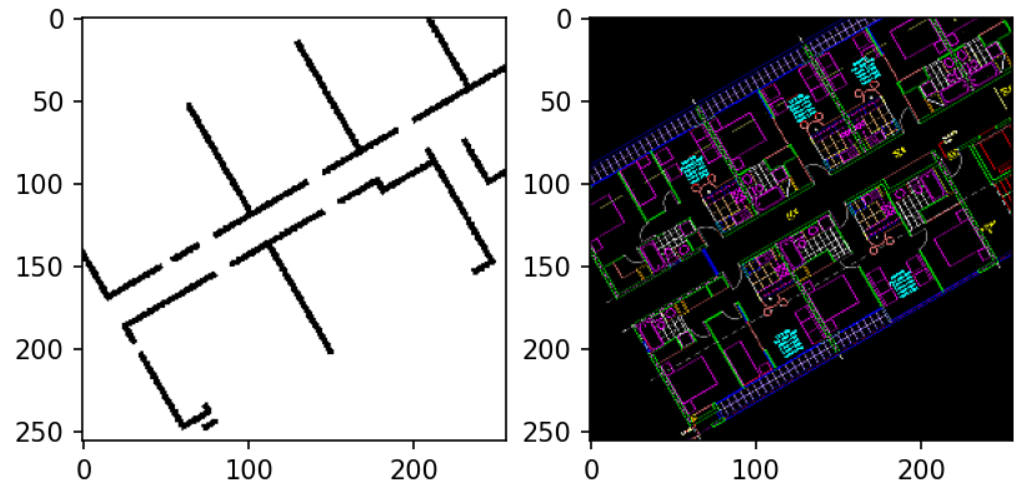


Machine Learning STRUCTural Floor Plan: A multi-unit floor plan dataset.
This repo contains the base library to load and parse floor plans from the MLSTRUCT-FP dataset, which contains over 954 large-scale floor plan images, alongside annotations for their walls in JSON format. The database loader loads in memory the Floor, Walls, and Slab objects, and also offers methods to create custom images from floor plans by applying a crop, a rotation, and a custom scaling.
The images can be generated from the real rasterized plan or by using the polygons stored in the JSON file. Both image and wall polygons are consistent in their placement.
See more information in our published article; also, check out the AI segmentation model that tests this dataset.
To install the library, use the following python-pip commands:
python -m pip install MLStructFPTo download the dataset (compressed in .zip), request a public download link by completing a simple form.
The dataset (uncompressed) has the following structure:
dataset/
0a0...736.png
0a7...b41.png
...
ff4...ff4.png
ffd...faf.png
fp.jsonEach image is stored in PNG format with a transparent background. Image size ranges between 6500 and 9500 px. Each file represents a distinct floor, whose labels (wall polygons, slabs) and metadata are stored within fp.json.
The format of the fp.json file is characterized as follows:
{
"rect": {
"1000393": {
"angle": 0.0,
"floorID": 8970646,
"length": 2.6,
"line": [
0.0,
-15.039,
0.0
],
"thickness": 0.2,
"wallID": 5969311,
"x": [
13.39,
15.99,
15.99,
13.39
],
"y": [
-14.939,
-14.939,
-15.139,
-15.139
]
},
...
},
"slab": {
"1002588": {
"floorID": 5980221,
"x": [
-1.153,
4.897,
4.897,
...
],
"y": [
-22.622,
-22.622,
-19.117,
...
],
},
...
},
"floor": {
"1014539": {
"image": "83d4b2b46052b81347c2c369076ce9e792da8b7c.png",
"scale": 193.412
},
...
}
}Note the dataset comprises a list of "rect" representing the rectangles (wall segments),
"slab," and "floor." Each item has a distinct ID for querying and grouping elements. In the example,
the rect ID 1000393 is within floor ID 8970646, with an angle of 0 degrees, a length
of 2.6 m, and within the wall ID 5969311. Likewise, the slab 1002588 is within floor
ID 5980221, whose its first point (x, y) is (-1.153, -22.622) m. Finally, the floor ID
1014539 is associated with the image 83d...8b7c.png and a scale 193.412 px/m. In total,
there are 70873 rects, 954 slabs and 954 floors.
The primary usage of the API is illustrated on the
jupyter notebook. The most fundamental
object is DbLoader,
which receives the path of the fp.json file.
class DbLoader(db: str)
# Example
db = DbLoader('test/data/fp.json')
db.tabulate()DbLoader creates a dict of Floor object,
which each contains a dict of Rect and
Slab objects. Each item is associated
with their respective IDs. Floor objects also have many methods to retrieve their elements, plot, and apply
transformations (aka mutations) such as scaling or rotation using the mutate() method:
class Floor:
...
def mutate(self, angle: NumberType = 0, sx: NumberType = 1, sy: NumberType = 1,
scale_first: bool = True) -> 'Floor':
...
# Example
plot_floor = db.floor[302]
plot_floor.mutate(30, 1, 1) # 30 degrees, scale one on the x-axis, one on the y-axis
plot_floor.plot_complex()Finally, the most important classes are RectBinaryImage and RectFloorPhoto, whose main responsibilities are creating plan crops for machine learning model training. These classes perform crops and downsampling on any image size and scale factor. For both objects, the main methods are:
def make_rect(self, rect: 'Rect', crop_length: NumberType = 5) -> Tuple[int, 'np.ndarray']:
def make_region(self, xmin: NumberType, xmax: NumberType, ymin: NumberType, ymax: NumberType,
floor: 'Floor', rect: Optional['Rect'] = None) -> Tuple[int, 'np.ndarray']:The first creates a crop around the provided rect (using its position as the center, adding crop_length m
for each axis). The second one creates a region on any arbitrary (xmin, ymin, xmax, ymax) region. Consider
each position in meters.
From the provided notebook example, the following image shows two crops generated using a mutated floor plan
with 30 30-degree angle rotation. Crops are 256x256 px`` in size and display a 10x10 m region for a selected
rectangle as the origin.
@article{Pizarro2023,
title = {Large-scale multi-unit floor plan dataset for architectural plan analysis and
recognition},
journal = {Automation in Construction},
volume = {156},
pages = {105132},
year = {2023},
issn = {0926-5805},
doi = {https://doi.org/10.1016/j.autcon.2023.105132},
url = {https://www.sciencedirect.com/science/article/pii/S0926580523003928},
author = {Pablo N. Pizarro and Nancy Hitschfeld and Ivan Sipiran}
}Pablo Pizarro R. | 2023 - 2024


